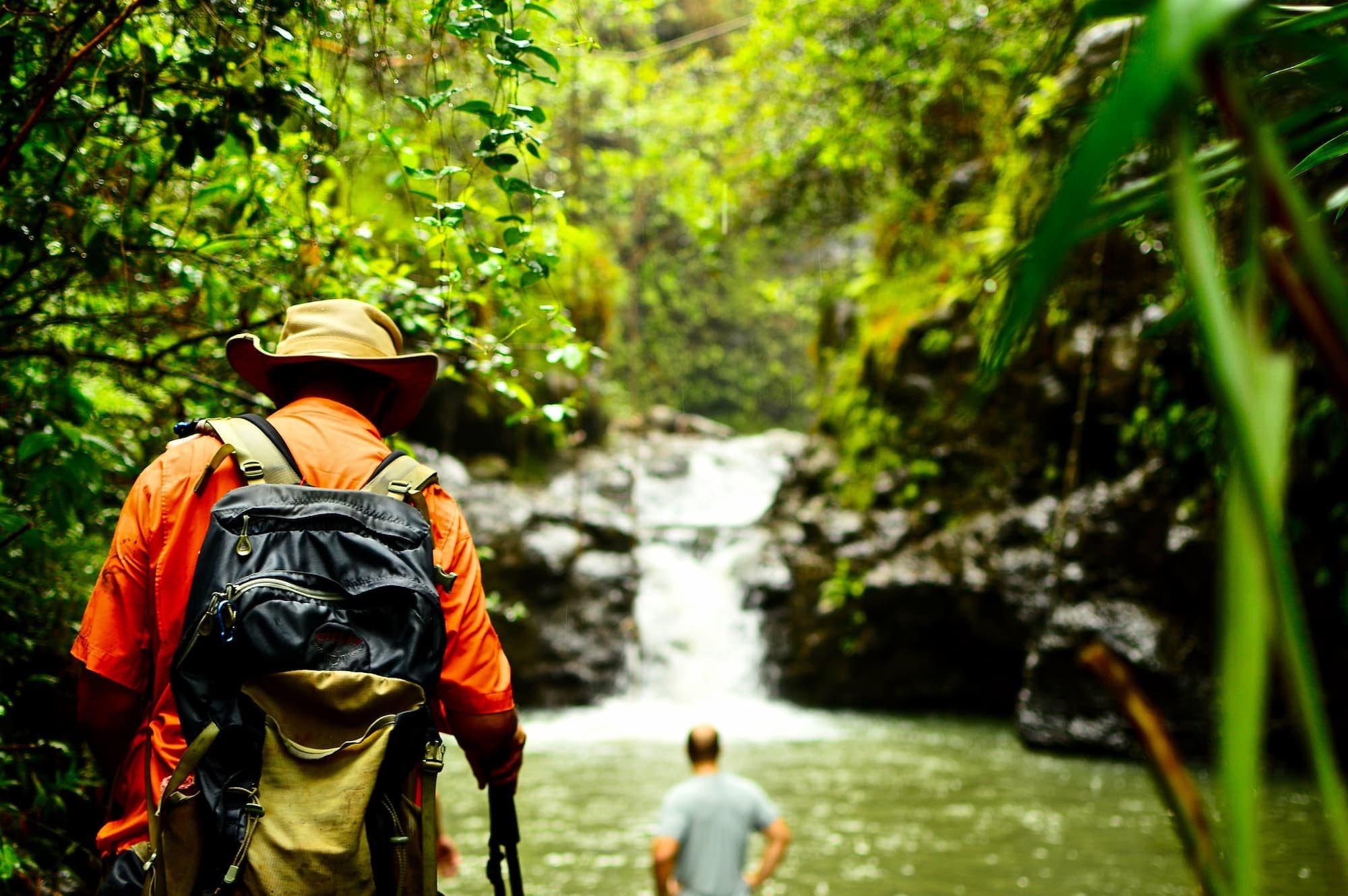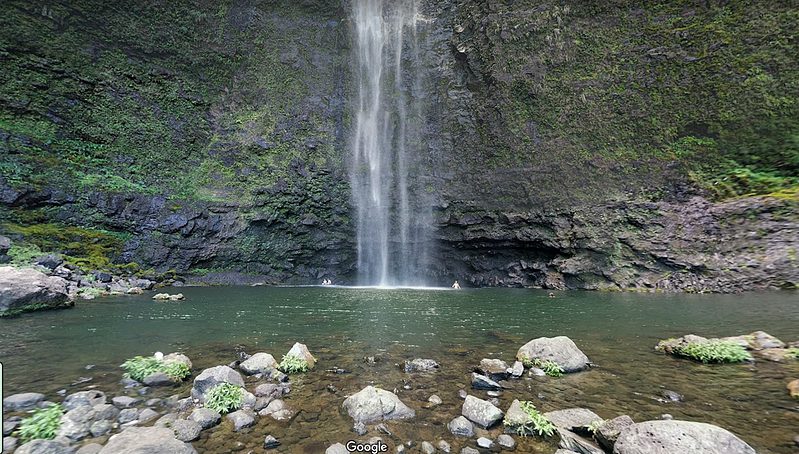Hawaiʻi is full of beautiful waterfalls, and they come in all shapes and sizes. Some are towering and majestic; others melodic and cascading. All can be enjoyed for their grace and power, but some offer an even more in-depth experience – the chance to swim beneath it.
Swimming isn’t possible at all waterfalls, but many have a large pool where swimming is possible. In this article, we dish on the best waterfalls in Hawaiʻi where you can swim, explaining where to find them and how to get the most of out your experience. We also discuss how to do so safely and some common pitfalls to avoid.
Table of contents
- Safety Brief: The ʻDos and Don’ts’ of swimming under waterfalls
- 1: Hanakapiai Falls (Kauaʻi)
- 2: Maunawili Falls (Oʻahu)
- 3: Twin Falls (Maui)
- 4: Uluwehi Falls (Kauaʻi)
- 5: Waimea Falls (Oʻahu)
- 6: Upper Waikani Falls (Maui)
- 7: Kulaniapia Falls (Big Island)
- 8: Waimano Falls (Oʻahu)
- 9: Waipoo Falls (Kauaʻi)
- 10: Ginger Pool (Oʻahu)
Table of Contents
- Safety Brief: The ʻDos and Don’ts’ of swimming under waterfalls
- 1: Hanakapiai Falls (Kauaʻi)
- 2: Maunawili Falls (Oʻahu)
- 3: Twin Falls (Maui)
- 4: Uluwehi Falls (Kauaʻi)
- 5: Waimea Falls (Oʻahu)
- 6: Upper Waikani Falls (Maui)
- 7: Kulaniapia Falls (Big Island)
- 8: Waimano Falls (Oʻahu)
- 9: Waipoo Falls (Kauaʻi)
- 10: Ginger Pool (Oʻahu)
Even more waterfalls!
There are many waterfalls in the state that didn’t make this list, and all of them are worth a visit. If waterfalls are your thing you should have a look at our related guides to waterfalls on Big Island, Kauaʻi, Maui, and Oʻahu:
- The best 5 waterfalls to visit on the Big Island
- 9 amazing Kauaʻi waterfalls
- Our 10 favorite waterfalls on Oʻahu
- 10 must-see Maui Waterfalls (+ how to get there)
The ʻDos and Don’ts’ of swimming under waterfalls
No matter the size or shape, waterfalls contain large amounts of beauty, and visitors will no doubt want to get up close and personal. As you’ll see, it’s possible to swim at many waterfalls, and we encourage everyone to enjoy this unique opportunity. However, there are a few things to keep in mind:
- If you have open cuts, stay out of the water. Bacteria causing the Leptospirosis disease live in many Hawaiian streams and can enter your body through open cuts and wounds. If you have a cut, it’s best to stay on shore and admire.
- Do not drink the water. Bacteria living in the water can make you sick.
- Wear water shoes or secured sandals while in the water, as rocks can be slippery and sharp.
- Never jump from a cliff and avoid swing ropes. You’ll no doubt see locals jumping off rocks and/or swinging from ropes at some waterfalls. Locals are experienced and familiar with the pools; you are not. Avoid putting yourself at unnecessary risk.
- Keep your distance from the falls itself. While it is nice to swim in the pool below the falls, we don’t recommend swimming directly under the waterfall. The pressure of the water can be intense, and sometimes rocks and other debris can come over the falls without warning and cause injury. We recommend keeping a safe distance from the actual falls when swimming in the pool below it.
The Best Swimmable Waterfalls in Hawaiʻi
Below, we rank the best waterfalls for swimming in Hawaiʻi. Please take the rankings with a grain of salt – all of these falls are wonderful experiences and worthwhile. In the descriptions, we provide details and a rationale for what makes them great and how to best enjoy them.
- Hanakapiai Falls (Kauaʻi)
- Maunawili Falls (Oʻahu)
- Twin Falls (Maui)
- Uluwehi Falls (Kauaʻi)
- Waimea Falls (Oʻahu)
- Upper Waikani Falls (Maui)
- Kulaniapia Falls (Big Island)
- Waimano Falls (Oʻahu)
- Waipoo Falls (Kauaʻi)
- Ginger Pool (Oʻahu)
1. Hanakapi’ai Falls (Kauaʻi)
Ready for an epic waterfall adventure on the Napali coast? You’ll have to hike eight miles roundtrip to experience it, but Hanakapiʻai is worth every step, and it all adds up to a day to remember. Start out with two miles along the spectacular, coastal Kalalau Trail to Hanakapiʻai Beach, then turn up into the rainforest and follow the stream for another two miles, hiking past bamboo forests to reach the 300-foot Hanakapiʻai Falls in back of the valley.
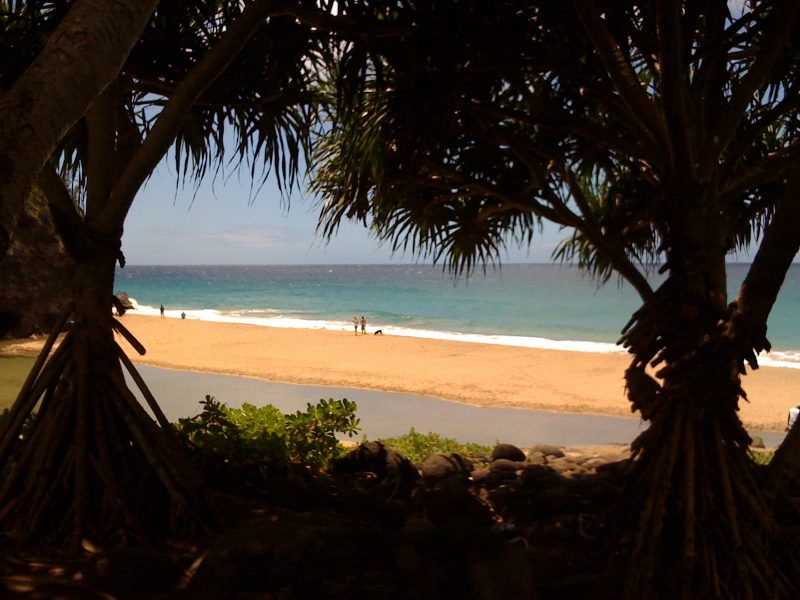
Hanakāpīʻai Beach on the Kalalau trail to Hanakāpīʻai Falls. Image credit: Sam Grover on Flickr.
Good to Know: The trail is well marked and well-worn, but this trek is not for hiking newbies, as it requires several river crossings and the mileage adds up. Plan on making this a full-day experience – bring plenty of food and water to energize yourself on the trail. Though you will be tempted, do not swim at Hanakapiʻai Beach. The currents here are extremely dangerous and many people have died. The trailhead begins at Keʻe Beach in Haʻena State Park; you will need to buy a parking permit in advance or take the shuttle from Hanalei. You need to have a reservation to enter Haʻena State Park. You can purchase parking permits, shuttle passes, and make a park reservation through the Go Haʻena website.
2. Maunawili Falls (Oʻahu)
Maunawili Falls can be reached via a 3-mile round trip hike through the lush jungles of O‘ahu’s windwardside. It’s not a large waterfall compared to others on this list – a cascading 20 to 30 feet – but it has a large pool that makes it easy to take a dip, and a popular hangout for locals. Getting there is part of the fun, as the hike takes you through dense rainforest with lots of tropical plant life and scenery.
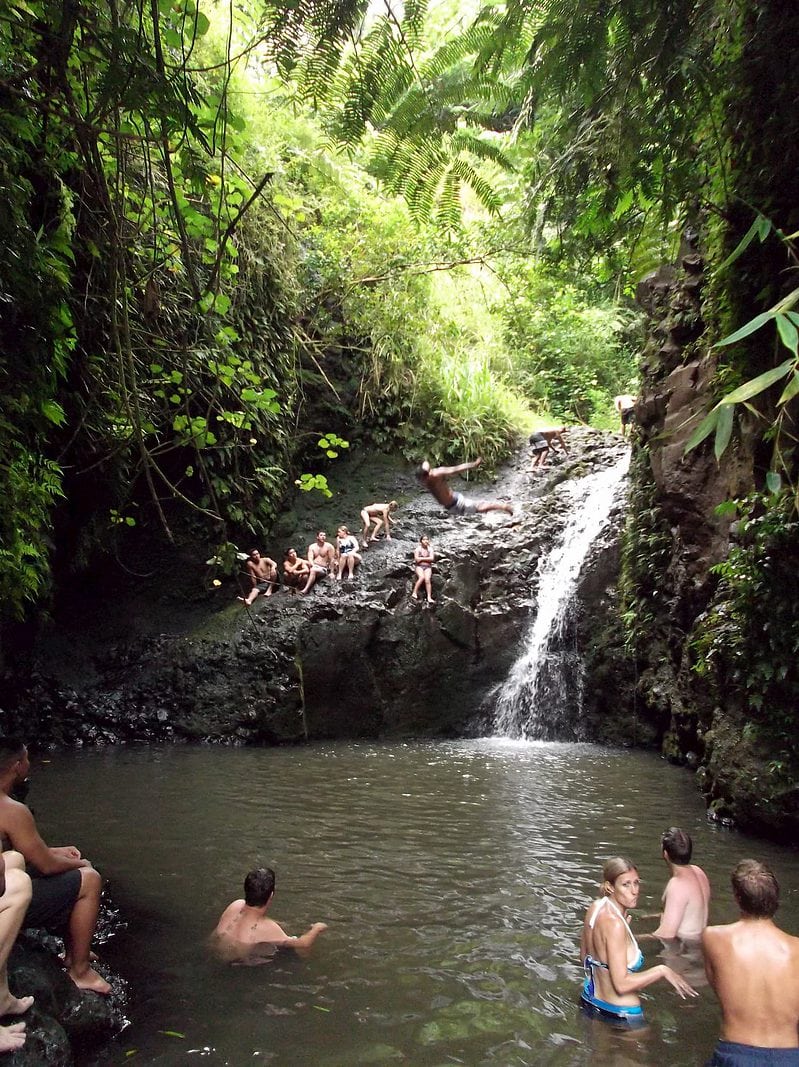
The Maunawili Falls are one of the waterfalls on O‘ahu suitable for swimming. Image credit: RKCR, source.
Good to Know: The Maunawili Falls trail is usually muddy, especially in the winter months, so be prepared to get dirty (keep a change of clothes/shoes in your trunk for after). You may see people cliff jumping into the pool below the falls, but we don’t recommend it. Changing water levels and submerged debris/rocks can cause severe injury. The trailhead begins in a residential neighborhood, so please respect residents and all posted signs.
3. Twin Falls (Maui)
The Road to Hāna has more waterfalls than one could explore in a day, but if you want to swim, a few stand out above the rest. One of the best options is Twin Falls on the Hāna Highway. About 40 feet in height and encased by rainforest, it has a storybook, circular swimming hole beneath it and requires just a three-quarter mile hike to reach (if you’re noticing a pattern about having to hike to these waterfalls, expect it to continue! For us, there’s something about having to work your way to the falls that makes it special and offers a unique sense of place).
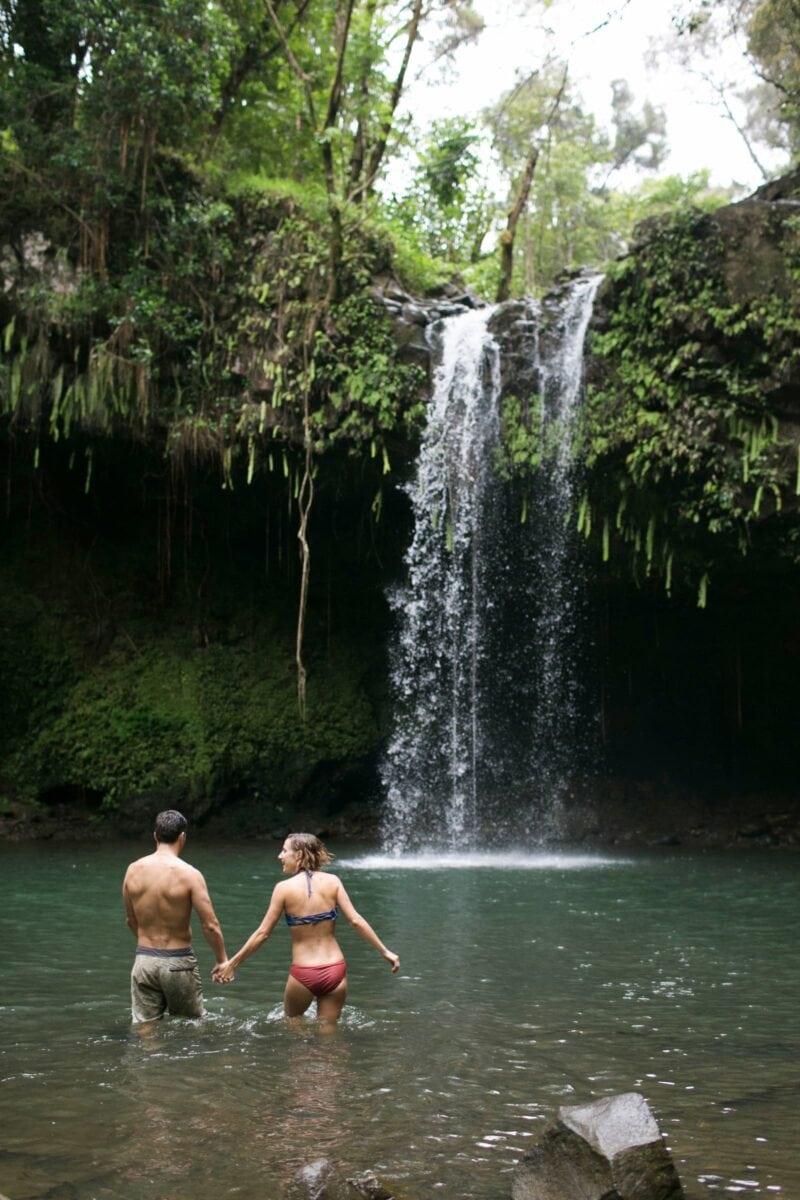
Located between mile marker 2 and 3, Twin Falls is the first easily accessible string of waterfalls and pools on the Road to Hana. Credit: Hawaii Tourism Authority (HTA)
Good to Know: This is the first waterfall along the Hāna Highway, so naturally, it is often visited. Don’t let that deter you. Twin Falls is perfect for families and less-experienced hikers because it offers a “backcountry” experience that’s easy to access and doesn’t require a lot of energy. After your hike out, enjoy a smoothie from the local fruit stand in the parking lot.
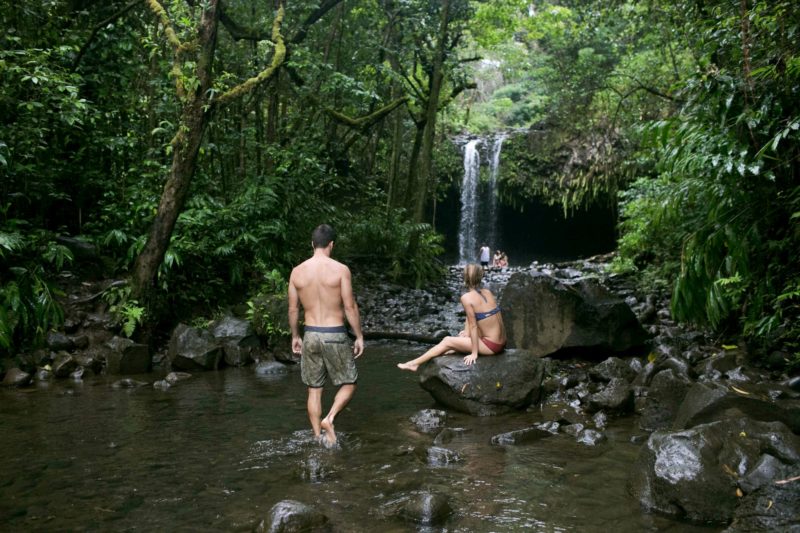
Make sure to bring a towel and wear swim gear when hiking to the Twin Falls. Credit: Hawaii Tourism Authority (HTA)
4. Uluwehi Falls (Kauaʻi)
Located in Wailua River State Park on Kauaʻi’s windwardside, Uluwehi Falls was once known as “Secret Falls” in the days prior to the Internet. Now, the nickname refers to the fact that it’s not easy or straightforward to reach. To arrive, you have to first kayak up the Wailua River, and then take a 20-minute hike through the jungle. The journey is worth it, of course, not only for its unique nature but because a beautiful swimming hole awaits you beneath this 100-foot falls.
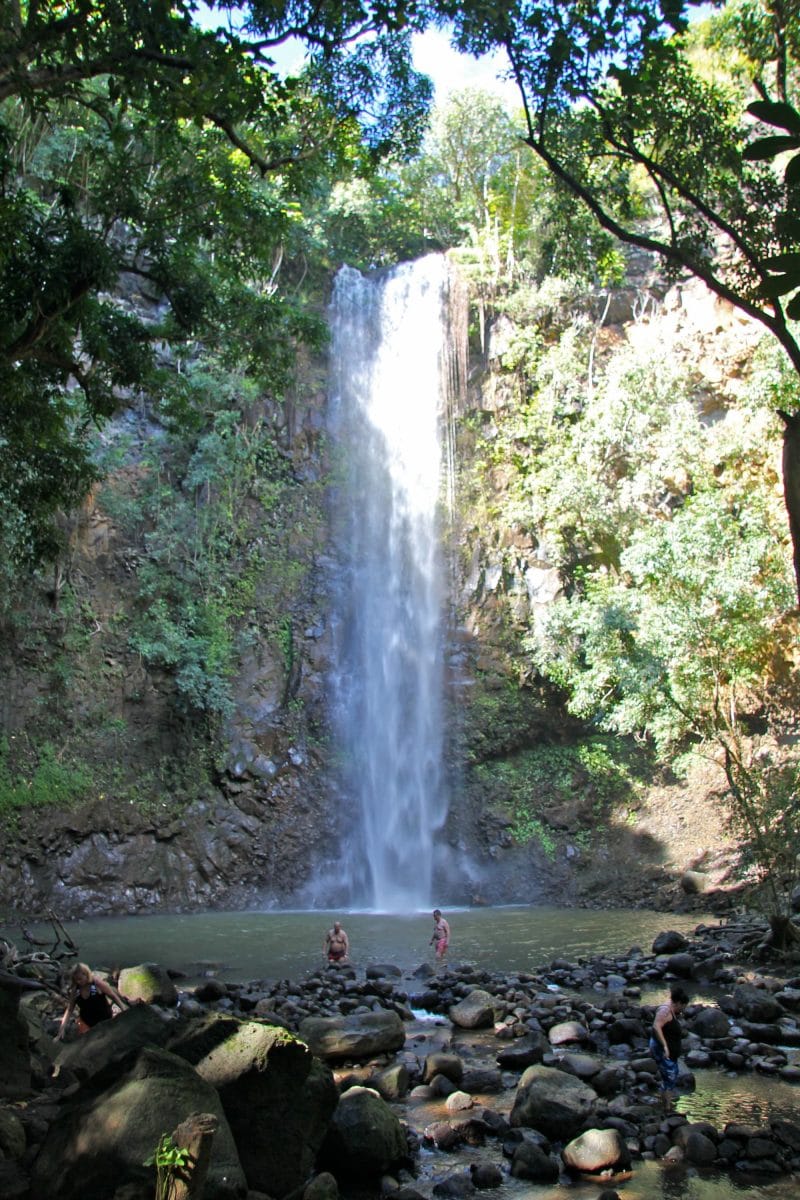
The Uluwehi (Secret) Falls. Swimming here is possible but it is not advisable to swim under the waterfall because stones can fall down with the water. Image credit: Joe Baz, source.
Good to Know: Given its location deep in Kauaiʻs backcountry, one must really know where they are going and be confident in their ability to both kayak and hike. Technically, you can reach this falls on your own, but we recommend taking a guided tour to ensure you reach it safely (and get the most out of the experience). Consider this one from Kayak Kauaʻi.
5. Waimea Falls (Oʻahu)
The 40-foot Waimea Falls is considered to be the safest swimmable waterfall in all of Hawaiʻi. Located inside the Waimea Valley Botanical Gardens, it is accessed via a paved walking trail (1.5 miles round trip) and the pool is monitored by lifeguards each and every day (lifejackets are required and provided). It’s the perfect waterfall for families with children, and the walk through the botanical garden in this secluded valley elevates the experience.
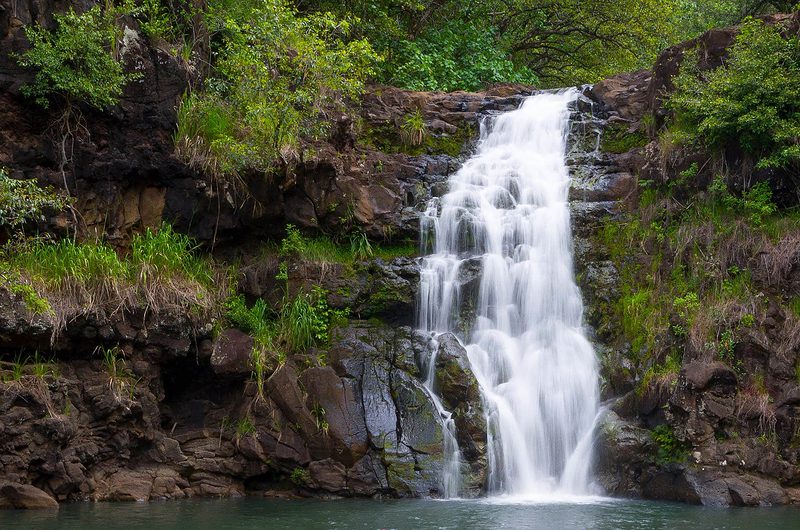
The Waimea Falls. Image credit: Thomas Shahan, source.
Good to Know: To walk to the waterfall, one must pay the entry fee for the botanical gardens ($20 adults/$12 kids). Don’t just rush out to the waterfall – check out the gardens and cultural exhibits along the way. You can easily make a day of your visit to Waimea Falls. Just across the street is Waimea Bay, one of the North Shore’s most iconic beaches and a great place for sunbathing and swimming in the summer months. For those with accessibility concerns, Waimea Falls is a great choice, as it also offers a shuttle service option from the visitor center to the falls ($8 round trip).
Honorable Mentions
There are many more swimmable waterfalls to explore throughout the islands. These aren’t quite as epic as our top five above, but they still have something to offer and are worth a visit if you’re in the area.
Upper Waikani Falls (Maui)
Also known as “Three Bears,” Upper Waikani is unique in that it features three side-by-side-by-side 70-foot waterfalls that all converge into one swimmable plunge pool. Needless to say, it’s an amazing site, offering a dramatic flair that is hard to find elsewhere.
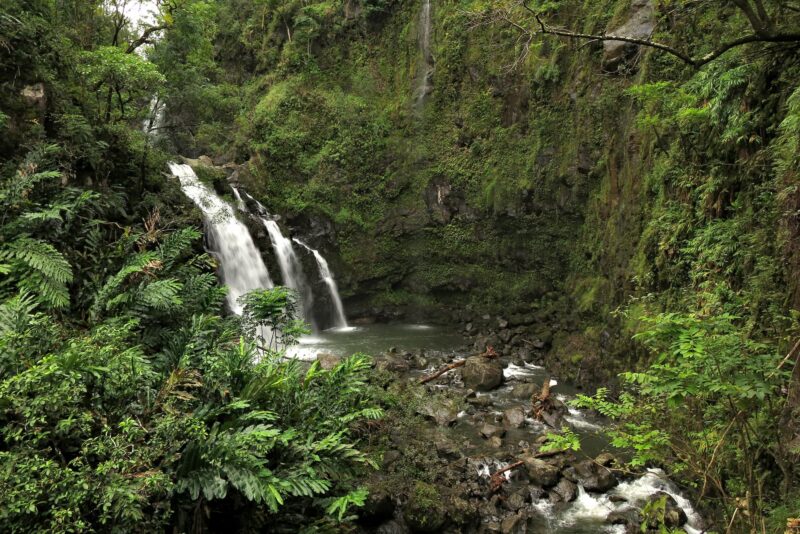
The upper Waikani Falls are a triple of large waterfalls amid rocks & lush vegetation. Image credit: Thomas Jundt, source.
Good to Know: Upper Waikani is located at Mile Marker 19 along the Road to Hāna. It is literally located just off the side of the road, visible from your car. With many people pulling over in this area, it can get quite congested, and its roadside location prevents it from having a remote feel. However, it is still an amazing place to stop and see and swim.
Kulaniapia Falls (Big Island)
Kulaniapia Falls is a 120-foot waterfall located on private property outside of Hilo town. It sits on the grounds of the Inn at Kulaniapia, and up until recently, access to the falls was limited to overnight guests only. Now, the Inn welcomes a limited amount of visitors per day to enjoy the falls and its swimming hole.
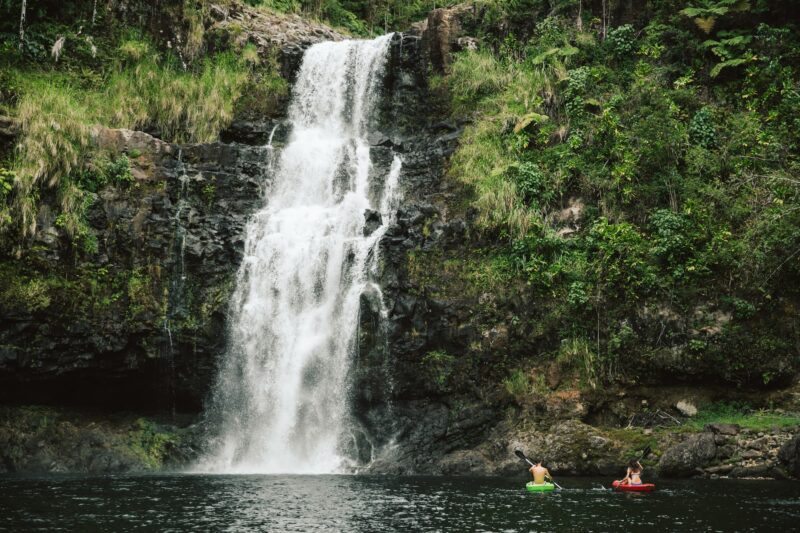
If conditions are suitable you can use on-property SUP and kayak equipment to explore the Kulaniapia waterfall. Credit: Hawaii Tourism Authority (HTA) / Heather Goodman
Good to know: Visiting Kulaniapia Falls requires a $49 daypass to the grounds. Or, perhaps you might consider spending a night at the Inn. The property also has miles of hiking trails and other waterfalls (4 total), as well as opportunities for kayaking, paddleboarding, and even waterfall rappelling.
Waimano Falls (Oʻahu)
Looking for another deep dive into Oʻahu’s jungles? The hike to Waimano Falls is not easy, and definitely not for beginners, but those who make the trek will be rewarded with a dip in its large, swimmable pool. Surrounded by thick rainforest, Waimano is a popular place for locals and usually not overcrowded thanks to its remote location.
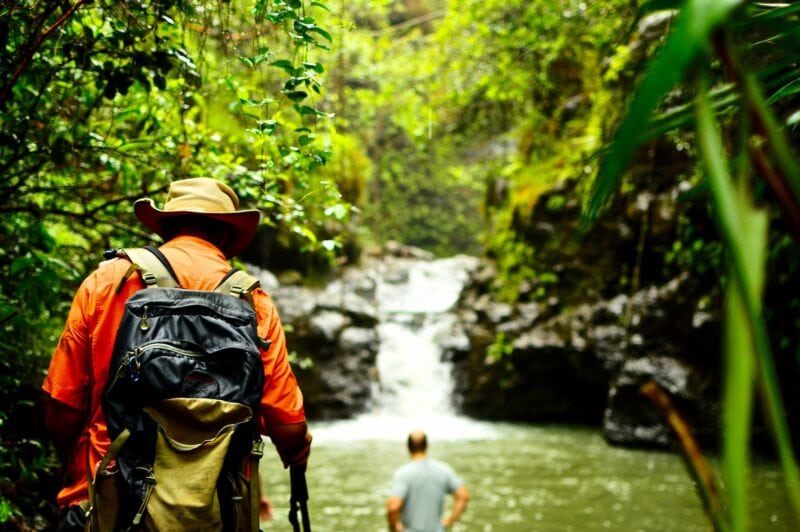
Waimano falls is located at the end of a normally moderate 2 mile hike. Source: Jason Jacob via Flickr CC BY-ND 2.0
Good to Know: The journey to the 30-foot Waimano Falls starts at the Mānana Ridge Trail outside of Pearl City. Be prepared for a slog, including mud and slippery uphill climbs. Do not jump or swim in the pool without first checking its depth, as water levels decrease during the summer months.
Waipoʻo Falls (Kauaʻi)
Located in Waimea Canyon, Waipoʻo Falls is absolutely gigantic, about 800-feet in total as it cascades its way down the red, rocky canyon walls. It can be explored via the Waipoʻo Falls Trail, which takes you to the top of the falls. Though it is not possible to swim under the falls (the bottom is way down below in the depths of Waimea Canyon), you can swim in the small pools located upstream from the falls in the Kokeʻe Stream.
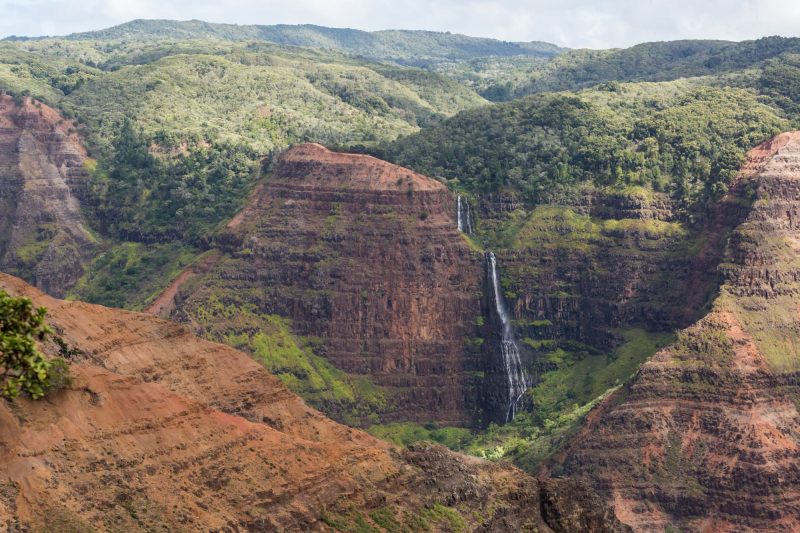
The Waipoʻo Falls as seen from a lookout along the canyon road. This hike described above ends at the top of the falls. Image: Hawaii Tourism Authority (HTA) / Tor Johnson
Good to Know: This adventure is considered one of the best family waterfall hikes on Kauaʻi for its dramatic and unique views, and it should be tackled regardless of whether or not you want to swim. Take in the views of Waipoʻo Falls from the lookouts in Waimea Canyon to gain some perspective on its size, then take the trail to its top. Wander upstream a bit until you find the swimming hole.
Ginger Pool (Oʻahu)
If you find yourself in Honolulu and are craving a dip in some fresh water, check out the quick-and-easy Ginger Pool just outside the city along the Pali Highway. The waterfall is small – just about ten feet – so the attraction is really the round swimming hole surrounded by rainforest.
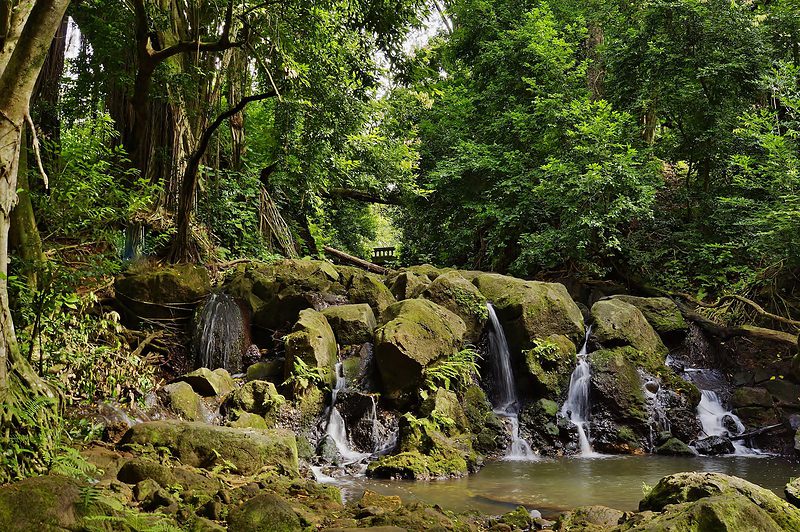
This small waterfall is known as the “Ginger Pool” and is located at the start of the Nuuanu Pali area on the Judd Trail. Source: Eric Tessmer via Flickr CC BY-ND 2.0
Good to Know: The Ginger Pool can be found on the Judd Trail across the Lulumahu Stream. We recommend taking a hike on the nearby Nuʻuanu Trail and finding your way to the Ginger Pool to cool off after.
